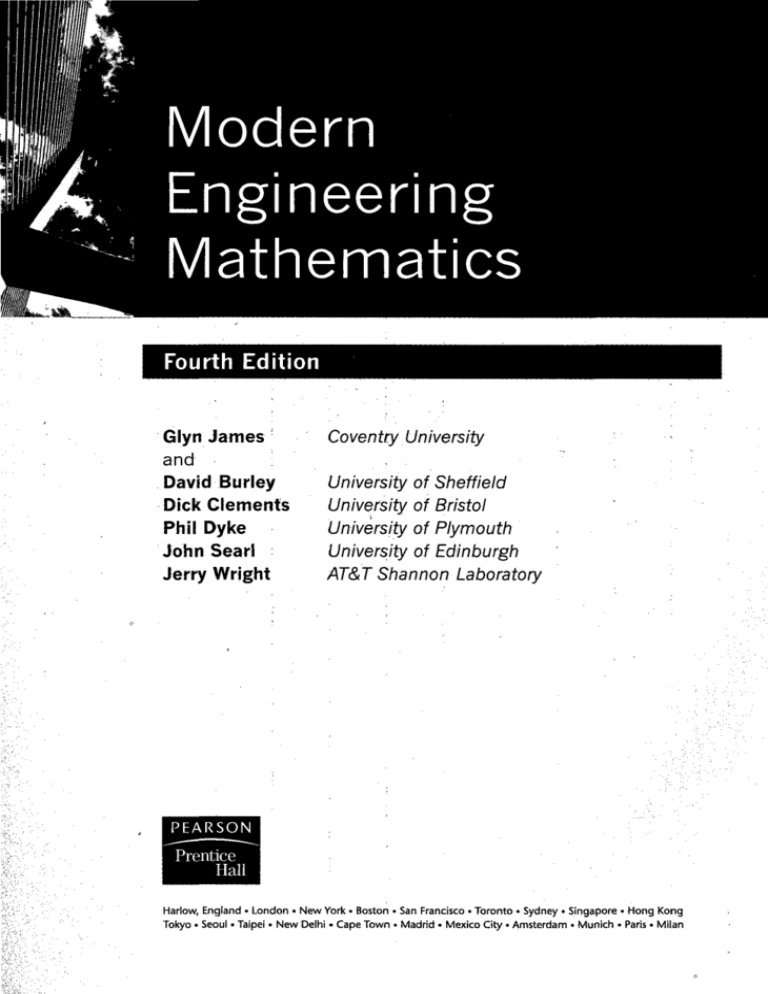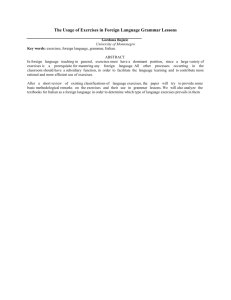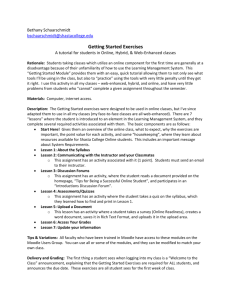
Modern
Engineering
Mathematics
Fourth Edition
Glyn James
and
; '
David Burley
Dick Clements
Phil Dyke
John Searl
Jerry Wright
Coventry University
University of Sheffield
University of Bristol
University of Plymouth
University of Edinburgh
AT&T Shannon Laboratory
PEARSON
Prentice
Hall
Harlow, England • London • New York • Boston • San Francisco • Toronto • Sydney • Singapore • Hong Kong
Tokyo • Seoul • Taipei • New Delhi • Cape Town • Madrid • Mexico City • Amsterdam • Munich • Paris • Milan
Contents
tr. •
Preface
:
About the authors
XXI
xxiv
Chapter 1 Numbers, Algebra and Geometry
1.1
Introduction
1*2
Number and arithmetic
1.2.1 Number line
1.2.2 Rules of arithmetic
1.2.3 Exercises (1-5)
1.2.4* Inequalities
1.2.5 Modulus and intervals
1.2.6 Exercises (6-10)
2
3
7
7
8
11
Algebra
'
1.3.1 Algebraic manipulation
1.3.2 Exercises (11-16)
1.3.3 Equations, inequalities and identities
1.3.4 Exercises (17-28)
;
'
1.3.5 Suffix, sigma and pi notation
1.3.6 Factorial notation and the binomial expansion
1.3.7 Exercises (29-31)
12
13
19
20
27
27
30
33
1.3
1.4
Geometry
1.4.1 Coordinates
1.4.2 Straight lines ;
1.4.3 Circles
•,. 1.4.4 Exercises (32-38)
1.4.5 Conies
1.4.6 Exercises (39-41)
Numbers and accuracy
t5.1 Representation of numbers
1.5,2 Rounding, decimal places and significant figures
2
33.
33
33
35
38
38
44
44
45
47
Vi
CONTENTS
1.5.3
1.5.4
1.5.5
1.5.6
Estimating the effect of rounding errors
Exercises (42-55)
Computer arithmetic
Exercises (56-58)
49
54
55
56
1.6
Engineering applications
56
1.7
Review exercises (1-25)
59
Chapter 2
Functions
2.1
Introduction
2.2
Basic definitions
2.2.1
2.2.2
2.2.3
2.2.4
2.2.5
2.2.6
2.2.7
2.3
2.4
:
Concept of a function
Exercises (1-6)
Inverse functions
Composite functions .
Exercises (7-13)
Odd, even and periodic functions
Exercises (14-15)
64
64
73
74
78
81
82
87
87
2.3.1
2.3.2
2.3.3
2.3.4
2.3.5
87
89
93
94
97
Linear functions
Least squares fit of a linear function to experimental data
Exercises (16-22)
The quadratic function
Exercises (23-28)
Polynomial functions
Basic properties
Factorization
Nested multiplication and synthetic division
Roots of polynomial equations
Exercises (29-37)
Rational functions
2.5.1
2.5.2
2.5.3
2.5.4
2.5.5
2.6
:
Linear and quadratic functions
2.4.1
2.4.2
2.4.3
2.4.4
2.4.5
2.5
64
Partial fractions
Exercises (38-41)
Asymptotes
Parametric representation
Exercises (42-46)
Circular functions
2.6.1 Trigonometric ratios
2.6.2 Exercises (47-53)
98
99
100
102
105
112
114
116
122
123
126
128
128
129
131
CONTENTS
2.6.3
2.6.4
2.6.5
2.6.6
2.6.7
2.6.8
2.6.9
2.7
2.8
Vii _-- s "
132
138
142
145
146
148
151
Circular functions
Trigonometric identities
Amplitude and phase
'
Exercises (54-65)
Inverse circular (trigonometric) functions
Polar coordinates
Exercises (66-70)
Exponential, logarithmic and hyperbolic functions
152
2.7.1
2.7.2
2.7.3
2.7A
2.7.5
2.7.6
152
155
157
157
162
164
Exponential functions
Logarithmic functions,
;
Exercises (71-79)
Hyperbolic functions
Inverse hyperbolic functions
Exercises (80-87)
'.
Irrational functions
164
2.8.1
2.8.2
2.8.3
2.8.4
Algebraic functions
Implicit functions
Piecewise defined functions
Exercises (88-97)
165
166
170
172
Numerical evaluation of functions
173
2.9.1 Tabulated functions and interpolation
2.9.2 Exercises (98-103) :
174
178
2.10
Engineering application: a design problem
179
2.11
Review exercises (1-23)
181
2.9
Chapter 3 Complex Numbers
3.1
Introduction
185
3.2
Properties
186
3.2.1
3.2.2
3.2.3
3.2.4
3.2.5
3.2.6
3.2.7
186
187
190
191
195
196
200
The Argand diagram
The arithmetic of complex numbers
Complex conjugate
Modulus and argument
Exercises (1-14)
Polar form of a complex number
Euler's formula
VIII
CONTENTS
3.2.8
3.2.9
3.2.10
3.2.11
3.3
3.4
208
3.3.1 De Moivre's theorem
3.3.2 Powers of trigonometric functions and multiple angles
3.3.3 Exercises (25-32)
208
212
215
Loci in the complex plane
216
Straight lines
Circles
More general loci
Exercises (33-41)
•
Functions of a complex variable
221
,
223
Engineering application: alternating currents in electrical networks
223
.3.6.1 Exercises (46-47)
3.7
216
217
219
220_
•
3.5.1 Exercises (42-45)
3.6
202
202
206
207
Powers of complex numbers
3.4.1
3.4.2
3.4.3
3.4.4
3.5
Exercises (15-18)
Relationship between circular and hyperbolic functions
Logarithm of a complex number
Exercises (19-24)
:
Review'exercises (1-34)
_225
:
225
Chapter 4 Vector Algebra
4.1
Introduction
230
4.2
Basic definitions and results
231
4.2.1
4.2.2
4.2.3
4.2.4
4.2.5
4.2.6
4.2.7,
4.2.8
4.2.9
4.2.10
4.2.11
4.2.12
231
233
235
241
247
249
251
257
258
268
269
275
Cartesian coordinates
Scalars and vectors
Addition of vectors
Cartesian components and basic properties
Complex numbers as vectors
Exercises (1-16)
The scalar product
Exercises (17-30)
The vector product
Exercises (31-42)
Triple products
Exercises (43-51)
CONTENTS
Iff
4.3
4.4
4.5
4.6
ix
The vector treatment of the geometry of lines and planes
276
4.3.1 Vector equation of a line
4.3.2 Vector equation of a plane
4.3.3 Exercises (52-67)
276
283
286
Engineering application: spin-dryer suspension
287
4.4.1 Point-particle model
287
Engineering application: cable stayed bridge
290
4.5.1 A simple stayed bridge
290
Review exercises (1-24)
292
Chapter 5 Matrix Algebra
5.1
Introduction
297
5,2
Definitions and properties
299
5.2.1
5.2.2
5.2.3
5.2.4
5.2.5
5.2.6
5.2.7
301
304
308
310
314
315
325
5.3
5.4
5.5
5.6
Definitions
Basic operations of matrices
Exercises (1-10) •
Matrix multiplication
Exercises (11-16)
Properties of matrix multiplication
Exercises (17-33)
Determinants
328
5.3.1 Exercises (34-50)
340
The inverse matrix
341
5.4.1 Exercises (51-59)
345
Linear equations
347
5.5.1
5.5.2
5.5.3
5.5.4
5.5.5
354
356
369
371
377
Exercises (60-71)
The solution of linear equations: elimination methods
Exercises (72-80)
The solution of linear equations: iterative methods
Exercises (81-86)
Rank
377
5.6.1 Exercises (87-95)
385
X
CONTENTS
5.7
The eigenvalue problem
387
5.7.1
5.7.2
5.7.3
5.7.4
5.7.5
5.7.6
5.7.7
5.7.8
387
389
395
396
400
400
402
403
The characteristic equation
Eigenvalues and eigenvectors
Exercises (96-97)
Repeated eigenvalues
Exercises (98-102)
Some useful properties of eigenvalues
Symmetric matrices
Exercises (103-107)
5.8
Engineering application: spring systems
5.8.1 A two-particle system
5.8.2 An n-particle system
403
404
404
5.9
Engineering application: steady heat transfer through
composite materials
407
5.9.1
5.9.2
5.9.3
5.9.4
407
408
408
410
5.10
Introduction
Heat conduction
The three-layer situation
Many-layer situation
Review exercises (1-26)
411
Chapter 6 An Introduction to Discrete Mathematics
6.1
Introduction
418
6.2
Set theory
418
6.2.1
6.2.2
6.2.3
6.2.4
6.2.5
419
420
422
422
427
6.3
6.4
Definitions and notation
Union and intersection
Exercises (1-8)
Algebra of sets
Exercises (9-17)
Switching and logic circuits
6.3.1 Switching circuits
6.3.2 Algebra of switching circuits
6.3.3 Exercises (18-29)
6.3.4 Logic circuits
6.3.5 Exercises (30-31)
429
430
436
437
441
Propositional logic and methods of proof
442
6.4.1 Propositions
6.4.2 Compound propositions
6.4.3 Algebra of statements
442
444
447
429
CONTENTS
XI
6.4.4 Exercises (32-37)
6.4.5 Implications and proofs
6.4.6 Exercises (38-4:7)
450
450
456
6.5
Engineering application: expert systems
457
6.6
Engineering application: control
459
6.7
Review exercises (1-23)
462
Chapter 7 Sequences, Series and Limits
7.1
Introduction
467
7.2
Sequences and series
467
7.2.1 Notation
7.2.2 Graphical representation of sequences
7.2.3 Exercises (1-13)
467
469
472
Finite sequences and series ,:.
474
7.3.1 Arithmetical sequences and series
7.3.2^ Geometric sequences and series
7.3.3 Other finite series
7.3.4 Exercises (14-25)
474
475
477
480
Recurrence relations
481
7.3
7.4
7.4.1 First-order linear recurrence relations with
constant coefficients
7.4.2 Exercises (26-28)
.
7.4.3 Second-order linear recurrence relations with
constant coefficients
7.4.4 Exercises (29-35)
7.5
Limit of a sequence
7.5.1
7.5.2
7.5.3
7.5.4
7.6
Convergent sequences
Properties of convergent sequences
Computation of limits
Exercises (36-40)
482
485
486
494
494
495
497
499
501
Infinite series
502
7.6.1
7.6.2
7.6.3
7.6.4
502
504
507
508
Convergence of infinite series
Testa for convergence of positive series
The absolute convergence of general series
Exercises (41-49)
Xii
CONTENTS
7.7
7.8
7.9
Power series
509
7.7.1 Convergence of power series
7.7.2 Special power series
7.7.3 Exercises (50-56)
509
511
517
Functions of a real variable
518
7.8.1 Limit of a function of a real variable
7.8.2 One-sided limits
7.8.3 Exercises (57-61)
518
522
524
Continuity of functions of a real variable
525
7.9.1
7.9.2
7.9.3
7.9.4
525
527
529
532
Properties of continuous functions
Continuous and discontinuous functions
Numerical location of zeros
Exercises (62-69)
7.10
Engineering application: insulator chain
532
7.11
Engineering application: approximating functions and
Pade approximants
533
Review exercises (1-25)
535
7.12
Chapter 8
Differentiation and Integration
8.1
Introduction
540
8.2
Differentiation
541
8.2.1
8.2.2
8.2.3
8.2.4
8.2.5
8.2.6
8.2.7
8.2.8
541
542
544
546
547
548
549
556
8.3
Rates of change
Definition of a derivative
Interpretation as the slope of a tangent
Differentiate functions
Speed, velocity and acceleration
Exercises (1-7)
Mathematical modelling using derivatives
Exercises (8-18)
Techniques of differentiation
557
8.3.1
8.3.2
8.3.3
8.3.4
558
560
564
564
Basic rules of differentiation
Derivative of xr
Exercises (19-23)
Differentiation of polynomial functions
CONTENTS xiii
8.3.5
8.3.6
8.3.7
8.3.8
8.3.9
8.3.10
8.3.11
8.3.12
8.3.13
8.3.14
8.3.15
8.4
8.5
8.6
8.7
8.8
8.9
Differention of rational functions
Differentiation of composite functions
Differentiation of inverse functions
Exercises (24-31)
Differentiation of circular functions
Extended form of the chain rule
Exercises (32-34)
Differentiation of exponential and related functions
Exercises (35-43)
Parametric and implicit differentiation
Exercises (44-54)
567
568
573
574
575
579
581
581
586
586
591
Higher derivatives
592
8.4.1
8.4.2
8.4.3
8.4.4
The second derivative
Exercises (55-67)
Curvature of plane curves
Exercises (68-71)
592
596
597
600
Applications to optimization problems
600
8.5.1 Optimal values
8.5.2 Exercises (72-81)
600
609
Numerical differentiation
8.6.1 The chord approximation
8.6.2 Exercises (82-86)
611
611
613
Integration
613
8.7.1
8.7.2
8.7.3
8.7.4
8.7.5
8.7.6
613
616
620
620
623
625
Basic ideas and definitions
Mathematical modelling using integration
Exercises (87-95)
Definite and indefinite integrals
The Fundamental Theorem of Calculus
Exercise (96)
Techniques of integration
625
8.8.1
8.8.2
8.8.3
8.8.4
8.8.5
8.8.6
625
636
637
640
640
645
Integration as antiderivative
Exercises (97-104)
Integration by parts
Exercises (105-107)
Integration by substitution
Exercises (108-116)
Applications of integration
646
8.9.1 Volume of a solid of revolution
8.9.2 Centroid of a Diane area
646
647
Xiv
CONTENTS
8.9.3
8.9.4
8.9.5
8.9.6
8.10
Centre of gravity of a solid of revolution
Mean values
.
Root mean square values
Arclength and surface area
649
649
650
650
8.9.7 Exercises (117-125)
656
Numerical evaluation of integrals
657
8.10.1 The trapezium rule
8.10.2 Simpson's rule
657
663
8.10.3 Exercises (126-131)
\
•
666
8.11
Engineering application: design of prismatic channels
667
8.12
Engineering application: harmonic analysis of periodic functions
669
8.13
Review exercises (1-39)
671
Chapter 9
Further Calculus
9.1
Introduction
680
9.2
Improper integrals
680
9.2.1 Integrand with an infinite discontinuity
9.2.2 Infinite integrals
9.2.3 Exercise (1)
681
684
685
Some theorems with applications to numerical methods
686
9.3.1 Rolle's theorem and the first mean value theorems
9.3.2 Convergence of iterative schemes
9,3.3 Exercises (2-7)
686
689
693
Taylor's theorem and related results
693
9.4.1
9.4.2
9.4.3
9.4.4
9.4.5
9.4.6
9A7
9.4.8
9.4.9
9.4.10
9.4.11
9.4.12
693
696
701
702
703
704
705
706
709
709
709
711
9.3
9.4
Taylor polynomials and Taylor's theorem
Taylor and Maclaurin series
L'Hopital's rule
Exercises (8-20)
Interpolation revisited
Exercises (21-23)
The convergence of iterations revisited
Newton-Raphson procedure
Optimization revisited
Exercises (24-27)
Numerical integration
Exercises (28-31)
:
CONTENTS
m
B
HI-
9.5
9.6
m.
BfflBSi
iH
9.7
m
W
I
XV
Calculus of vectors
712
9.5.1 Differentiation and integration of vectors
9.5.2 Exercises (32-36)
712
714
Functions of several variables
715
9.6.1
9.6.2
9.6.3
9.6.4
9.6.5
9.6.6
9.6.7
9.6.8
9.6.9
9.6.10
9.6.11
9.6.12
715
717
721
724
725
729
729
733
733
736
737
739
Representation of functions of two variables
Partial derivatives
Directional derivatives
Exercises (37-46)
The chain rule ;
Exercises (47-55)
Successive differentiation
Exercises (56-64)
The total differential and small errors
Exercises (65-72)
Exact differentials
Exercises (73-75)
Taylor's theorem for functions of two variables
739
9.7.1
9.7.2
9.7.3
9.7.4
9.7.5
740
743
748
749
753
Taylor's theorem
Optimization of unconstrained functions
Exercises (76-84)
Optimization of constrained functions
Exercises (85-90)
9.8
Engineering application: deflection of a built-in column
754
9.9
Engineering application: streamlines in fluid dynamics
756
Review exercises (1-35)
759
9.10
Chapter 10 Introduction to Ordinary Differential Equations
10.1
Introduction
765
10.2
Engineering examples
765
10.2.1
10.2.2
10.2.3
10.2.4
765
767
768
769
10.3
The take-off run of an aircraft
Domestic hot-water supply
Hydro-electric power generation
Simple electrical circuits
The classification of differential equations
770
10.3.1 Ordinary and partial differential equations
10.3.2 Independent and dependent variables
771
771
XVI
CONTENTS
10.3.3
10.3.4
10.3.5
10.3.6
10.4
10.5
10.6
The order of a differential equation
Linear and nonlinear differential equations
Homogeneous and nonhomogeneous equations
Exercises (1-2)
772
773
774
775
Solving differential equations
776
10.4.1
10.4.2
10.4.3
10.4.4
10.4.5
Solution by inspection
General and particular solutions
Boundary and initial conditions
Analytical and numerical solution
Exercises (3-6)
776
111
118
781
782
First-order ordinary differential equations
783
10.5.1
10.5.2
10.5.3
10.5.4
783
786
786
788
10.5.5
A geometrical perspective
Exercises (7-10)
Solution of separable differential equations
Exercises (11-17)
dx
f x ~\
Solution of differential equations of —- = fl - form
10.5.6
10.5.7
10.5.8
10.5.9
10.5.10
10.5.11
Exercises (18-22)
Solution of exact differential equations
Exercises (23-30)
Solution of linear differential equations
Solution of the Bernoulli differential equations
Exercises (31-38)
791
791
794
795
799
801
Numerical solution of first-order ordinary differential equations
802
10.6.1
10.6.2
10.6.3
10.6.4
803
805
808
810
A simple solution method: Euler's method
Analysing Euler's method
Using numerical methods to solve engineering problems
Exercises (39-45)
789
10.7
Engineering application: analysis of damper performance
811
10.8
Linear differential equations
816
10.8.1 Differential operators
10.8.2 Linear differential equations
10.8.3 Exercises (46-54)
816
818
824
Linear constant-coefficient differential equations
826
10.9.1
10.9.2
10.9.3
10.9.4
826
831
832
838
10.9
Linear homogeneous constant-coefficient equations
Exercises (55-61)
Linear nonhomogeneous constant-coefficient equations
Exercises (62-65)
CONTENTS
10.10
10.11
Engineering application: second-order linear constant-coefficient
differential equations •
,
839
10.10.1
10.10.2
10.10.3
10.10.4
10.10.5
839
843
846
850
851
Free oscillations of elastic systems
Free oscillations of damped elastic systems
Forced oscillations of elastic systems
Oscillations in electrical circuits
Exercises (66-73)
10.13
Chapter 11
'
Numerical solution of seconds arid higher-order
differential equations
853
10.11.1 Numerical solution of coupled first-order equations
10.11.2 State-space representation of higher-order systems
853
856
10.11.3 Exercises (74-79)
10.12
XVII
:
Qualitative analysis of second-order differential equations
859
10.12.1 Phase-plane plots
10.12.2 Exercises (80-81)
861
861
865
Review exercises (1-35)
866
Introduction to Laplace Transforms
11.1
Introduction
874
1.1.2
The Laplace transform
876
11.2.1
11.2.2
11.2.3
11.2.4
11.2.5
11.3
Definition and notation
Transforms of simple functions
Existence of the Laplace transform
Properties of the Laplace transform
Table of Laplace transforms
876
878
; 881
883
891
11.2.6
Exercises (1-3)
892
11.2.7
11.2.8
11.2.9
The inverse transform
Evaluation of inverse transforms
Inversion using the first shift theorem
892
893
895
11.2.10 Exercise (4)
897
Solution of differential equations
897
11.3.1 Transforms of derivatives
11.3.2 Transforms of integrals
11.3.3 Ordinary differential equations
897
899
900
11.3.4 Exercise (5)
906
11.3.5 Simultaneous differential equations
907
11.3.6 Exercise (6)
•
909
xviii CONTENTS
11.4
;
Engineering applications; electrical circuits and
mechanical vibrations
11.4.1 Electrical circuits
11.4.2 Mechanical vibrations
11.4.3 Exercises (7-12)
;
11.5
Chapter 12
:
Review exercises (1-18)
910
910
915
919
920
Introduction to Fourier Series
12.1
Introduction
925
12.2
Fourier series expansion
926
12.2.1
12.2.2
12.2.3
12.2.4
12.2.5
12.2.6
12.2.7
12.2.8
12.2.9
12.2.10
12.2.11
926
927
928
931
938
942
944
946
949
951
953
12.3
Periodic functions :
:
Fourier's theorem
,
The Fourier coefficients
Functions of period:2rr • ' ,'
Even and odd functions . ';.
Even and odd harmonics ;
Linearity property
Convergence of the Fourier series
Exercises (1-7)
Functions of period T
Exercises (8-13)
Functions defined over a finite interval
12.3.1 Full-range series
12.3.2 Half-range cosine and sine series
12.3.3 Exercises (14-23)
12.4
12.5
12.6
Differentiation and integration of Fourier series
954
954
956
960
12.4.1 Integration of:a Fourier series
12.4.2 Differentiation of a Fourier series
12.4.3 Exercises (24-26)
961
961
964
965
Engineering application: analysis of a
slider-crank mechanism
966
Review exercises (1-21.)
969
CONTENTS
Chapter 13
Xix
Data Handling and Probability Theory
13.1
Introduction"
974
13.2
The raw material of statistics
13.2.1 Experiments and sampling
13.2.2 Histograms of data
13.2.3 Alternative types of plot
13.2.4 Exercises (1-5)
975
Probabilities of random events
980
980
981
982
984
988
991
13.3
13.3.1
13.3.2
13.3.3
13.3.4
13.3.5
13.3.6
13.4
Interpretations, of probability
Sample space and events
Axioms, of probability
Conditional probability
Independence
Exercises (6-23)
Random variables
13.4.1 Introduction and definition
13.4.2 Discrete random variables
13.4.3 Continuous random variables
13.4.4 • Properties of density and distribution functions
13.4.5 Exercises (24-31)
13.4.6 •• Measures of location and dispersion
13.4.7 Expected values
13.4.8 Independence of random variables
13.4.9 Scaling and adding random variables
13.4.10 Measures from sample data
13.4.11 Exercises (32-48)
13.5
Important practical distributions
13.5.1
13.5.2
13.5.3
13.5.4
13.5.5
13.5.6
13.5.7
13.6
The binomial distribution
The Poisson distribution
•.
The normal distribution
The central limit theorem
Normal approximation to the binomial
Random variables for simulation
Exercises (49-65)
••'
Engineering application: quality control
13.6-1 Attribute control charts
13.6.2 United States standard attribute charts
13.6.3 Exercises (66-67)
975
975
978
980
992
992
993
994
995
998
998
1002
1003
1004
1007
1011
1013
1013
1015
1018
1021
1024
1026
1027
1029
1029
1031
1032
XX
CONTENTS
13.7
13.8
Appendix I
Al.l
AI.2
AI.3
AI.4
Engineering application: clustering of rare events
1032
13.7.1 Introduction
13.7.2 Survey of near-misses between aircraft
13.7.3 Exercises (68-69)
1032
1033
1035
Review exercises (1-1.3)
1035
Tables
Some useful results
Trigonometric identities
Derivatives and integrals
Some useful standard integrals
1038
1038
1041
1042
1043
Answers to Exercises
1044
Index
1082








